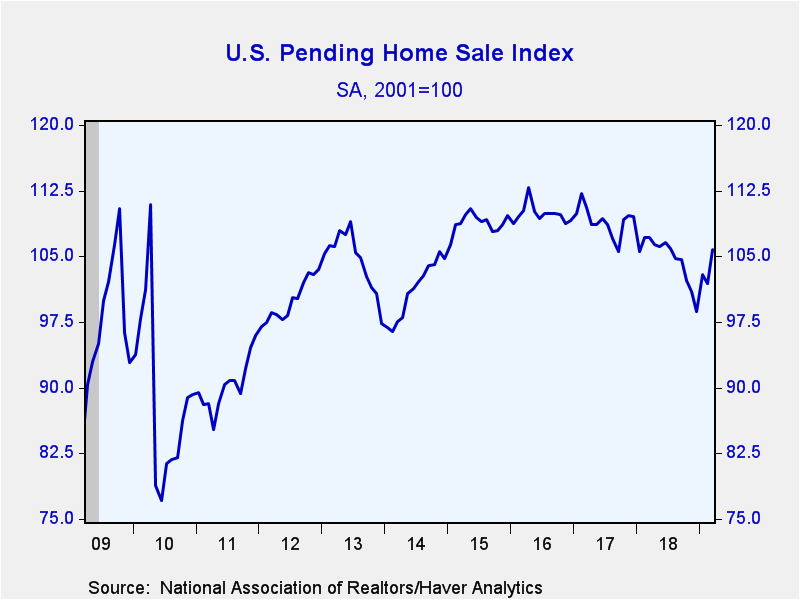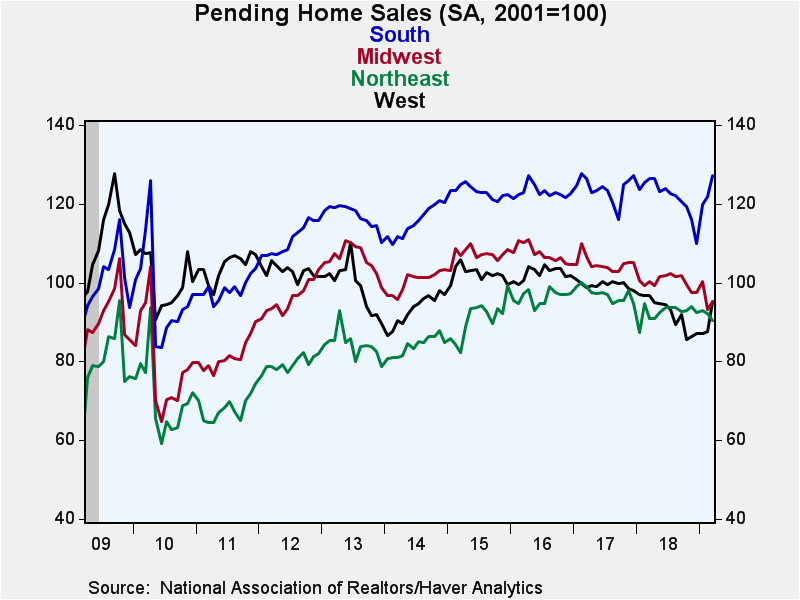 Global| Apr 30 2019
Global| Apr 30 2019U.S. Pending Home Sales Rebound
Summary
The National Association of Realtors (NAR) reported that pending home sales jumped 3.8% in March (-1.2% year-on-year). Pending sales declined for most of 2018, dropping in December to its lowest level since April 2014. Pending sales [...]
The National Association of Realtors (NAR) reported that pending home sales jumped 3.8% in March (-1.2% year-on-year). Pending sales declined for most of 2018, dropping in December to its lowest level since April 2014. Pending sales are up 7.2% since the end of last year.
The number of signed contracts rose in every region of the country except the Northeast. Pending sales jumped 8.7% in the West (-1.6% y/y), rose 4.4% in the South (0.7% y/y), and increased 2.3% in the Midwest (-5.0% y/y). Activity declined 1.7% (-0.4% y/y) in the Northeast.
The pending home sales index measures sales at the time the contract for an existing home is signed, analogous to the Census Bureau's new home sales data. In contrast, the National Association of Realtors' existing home sales data are recorded when the sale is closed. In developing the pending home sales index, the NAR found that the level of monthly sales contract activity anticipates the level of closed existing home sales in the following two months. The series dates back to 2001, and the data are available in Haver's PREALTOR database.
| Pending Home Sales (SA, 2001=100) | Mar | Feb | Jan | Mar Y/Y % | 2018 | 2017 | 2016 |
|---|---|---|---|---|---|---|---|
| Total | 105.8 | 101.9 | 102.9 | -1.2 | 104.7 | 109.1 | 109.8 |
| Northeast | 90.5 | 92.1 | 92.8 | -0.4 | 92.4 | 97.1 | 96.4 |
| Midwest | 95.3 | 93.2 | 100.4 | -5.0 | 100.2 | 104.9 | 107.4 |
| South | 127.2 | 121.8 | 119.8 | 0.7 | 121.6 | 123.9 | 123.0 |
| West | 95.1 | 87.5 | 87.1 | -1.6 | 92.3 | 99.5 | 102.3 |
Gerald D. Cohen
AuthorMore in Author Profile »Gerald Cohen provides strategic vision and leadership of the translational economic research and policy initiatives at the Kenan Institute of Private Enterprise.
He has worked in both the public and private sectors focusing on the intersection between financial markets and economic fundamentals. He was a Senior Economist at Haver Analytics from January 2019 to February 2021. During the Obama Administration Gerald was Deputy Assistant Secretary for Macroeconomic Analysis at the U.S. Department of Treasury where he helped formulate and evaluate the impact of policy proposals on the U.S. economy. Prior to Treasury, he co-managed a global macro fund at Ziff Brothers Investments.
Gerald holds a bachelor’s of science from the Massachusetts Institute of Technology and a Ph.D. in Economics from Harvard University and is a contributing author to 30-Second Money as well as a co-author of Political Cycles and the Macroeconomy.







